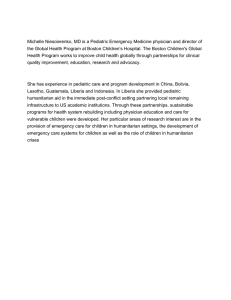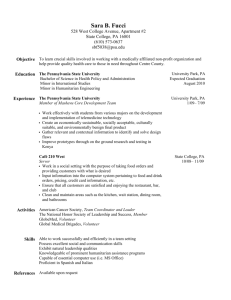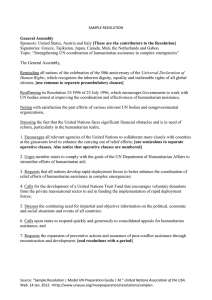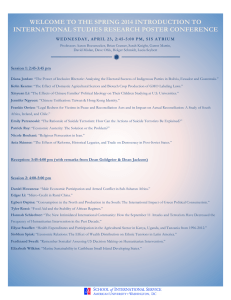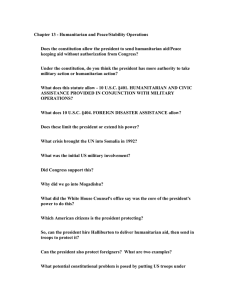Human Rights Council Advisory Committee QUESTIONNAIRE
advertisement
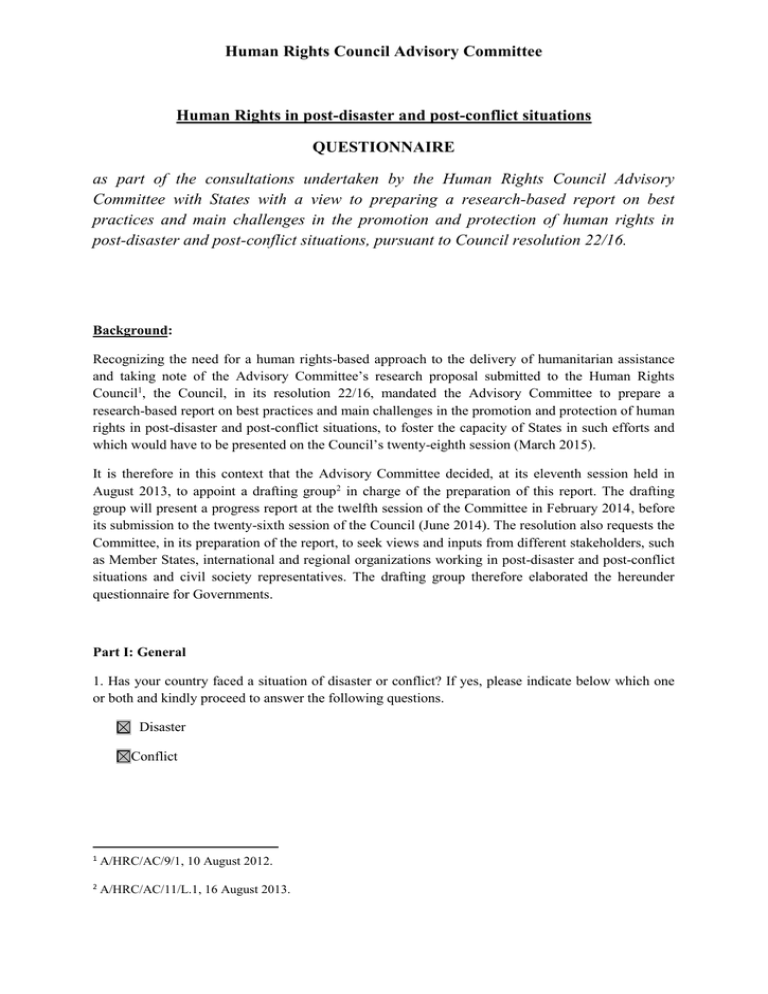
Human Rights Council Advisory Committee Human Rights in post-disaster and post-conflict situations QUESTIONNAIRE as part of the consultations undertaken by the Human Rights Council Advisory Committee with States with a view to preparing a research-based report on best practices and main challenges in the promotion and protection of human rights in post-disaster and post-conflict situations, pursuant to Council resolution 22/16. Background: Recognizing the need for a human rights-based approach to the delivery of humanitarian assistance and taking note of the Advisory Committee’s research proposal submitted to the Human Rights Council1, the Council, in its resolution 22/16, mandated the Advisory Committee to prepare a research-based report on best practices and main challenges in the promotion and protection of human rights in post-disaster and post-conflict situations, to foster the capacity of States in such efforts and which would have to be presented on the Council’s twenty-eighth session (March 2015). It is therefore in this context that the Advisory Committee decided, at its eleventh session held in August 2013, to appoint a drafting group2 in charge of the preparation of this report. The drafting group will present a progress report at the twelfth session of the Committee in February 2014, before its submission to the twenty-sixth session of the Council (June 2014). The resolution also requests the Committee, in its preparation of the report, to seek views and inputs from different stakeholders, such as Member States, international and regional organizations working in post-disaster and post-conflict situations and civil society representatives. The drafting group therefore elaborated the hereunder questionnaire for Governments. Part I: General 1. Has your country faced a situation of disaster or conflict? If yes, please indicate below which one or both and kindly proceed to answer the following questions. Disaster Conflict 1 A/HRC/AC/9/1, 10 August 2012. 2 A/HRC/AC/11/L.1, 16 August 2013. Part II: Post-disaster situations 1. Does your Government have a specific mechanism to deal with disasters? Does it have operational guidelines on a human rights-based approach in such situations? Which human rights do you focus on? The Italian Cooperation Humanitarian Office is entitled to intervene in post-disaster situations supporting relief and recovery initiatives but also investing in resilience and preparedness in disasterprone Countries, to strengthen the capacity of local people in preventing, mitigating and responding to disasters. Moreover in June 2012, specific Guidelines for Humanitarian Aid were adopted, reaffirming the need to provide relief and protection in accordance with humanitarian values and human rights. In this regard, the Italian humanitarian action strives to ensure the provision of food, water and sanitation, shelter and health services to affected people and facilitate the return to normal lives and livelihoods. 2. How does your Government ensure transparency and accountability in disaster responses and postdisaster recovery (including in connection with food distribution, building and infrastructure reconstruction)? At multilateral level the implementation of the humanitarian programmes is monitored through annual reports delivered by the implementing agencies/partners or by specific monitoring and evaluation missions. In relation to learning and accountability of bilateral and multi-bilateral initiatives, since October 2009 a result-based monitoring system was integrated to project cycle management enabling to measure performance of all humanitarian activities carried out. 3. What specific attention, if any, do you give to the needs of the following groups: children, women, indigenous peoples, elderly, persons with disabilities, minorities, non-citizens, including migrant workers? In general, special attention is given to vulnerable groups in delivering humanitarian assistance. With regard to children, women and persons with disabilities, the Italian Cooperation has developed specific guidelines which cover, for instance, the promotion of initiatives for the social reintegration of ex-combatants minors and children victims of conflict; or a more accurate definition of the needs and the rights of persons with disabilities in catastrophes and natural disasters. 4. What protections/standards do you have in place to ensure non-discrimination and respect of the humanitarian principles of humanity, neutrality, impartiality and independence in the provision of services, relief, etc.? The Italian Government has signed and promotes the most important international agreements on humanitarian aid. Notable among these are: the Universal Declaration of Human Rights (1948) and related treaties; the Geneva Conventions and their Additional Protocols of 1949 on humanitarian law; the Geneva Convention of 1951 Relating to the Status of Refugees; and the International Convention on the Rights of the Child, dating from 1989. At the European level, this tradition was reaffirmed by the adoption of the European Consensus on Humanitarian Action in 2007. Lastly, Italy is part of the Good Humanitarian Donorship Initiative. Italy conforms its humanitarian interventions to all relevant international principles and standards on human rights and relief, particularly those expressed in the European Consensus on Humanitarian Aid, the Resolution 46/182 of the General Assembly of the United and the Good Humanitarian Donorship Initiative. 2 5. Please give examples of culturally-relevant/responsive responses and actions, e.g. in terms of food, clothing, etc., and of religiously relevant/responsive responses and actions, including separate facilities for men/women, facilities for worship, clothing, food. In case of disaster response, Italian humanitarian action devotes particular attention to put in place responsive actions that take into due consideration cultural differences in exposed countries, in accordance with the local authorities . 6. What are the main challenges you face in applying protection and promotion of human rights in post-disaster situations? The ‘access’ issue remains the greatest obstacle, that often hinders the delivery of humanitarian assistance and the fulfilment of the humanitarian action in general, forcing even to use the mechanism of ‘remote control’, as in Somalia, for providing humanitarian assistance, also in post-disasters situations. 7. What best practices can you mention in the promotion and protection of human rights in postdisaster situations? ‘Lesson learned’ from the UN Family and the Red Cross Family. 8. What specific measures, if any, do you apply to ensure transparency in the implementation of funds for disaster relief? See answer 2 Part III: Post-conflict situations 1. Does your Government have a specific mechanism to deal with post-conflict situations? Does it have operational guidelines on a human rights-based approach in such situations? Which human rights do you focus on? The Italian Cooperation Humanitarian Office also acts in post-conflict situations and fragile states in respect of the principles for Good Internationl Engagement in Fragile States and Situations. It recognises the need to focus its strategy on institution and capacity building initiatives. The importance of state-building, with a view to strengthening local resilience mechanism in fragile contexts is also reaffirmed in the Good Humanitarian Donorship (GHD) Guidelines approved in June 2012. In this regard, the Italian Humanitarian action strives to ensure the provision of food, water and sanitation, shelter and health services to conflict-affected people and facilitate the return to normal lives and livelihoods. 2. How does your Government ensure transparency and accountability in post-conflict recovery (including in connection with food distribution, building and infrastructure reconstruction)? 3 See answer 2 of the previous section 3. What specific attention, if any, do you give to the needs of the following groups: children, women, indigenous peoples, elderly, persons with disabilities, minorities, non-citizens, including migrant workers? Special attention is given to vulnerable groups in delivering humanitarian assistance. The specific conditions of people living in fragile states and situations are taken into consideration in different Thematic Guidelines on Women Empowerment, Children and Disability. With regard to children, special concern is given to former child soldiers and victims of any form of violence. 4. What protections/standards do you have in place to ensure non-discrimination and respect of the humanitarian principles of humanity, neutrality, impartiality and independence in provision of services, relief, etc.? See answer 4 of the previous section 5. Please give examples of culturally-relevant/responsive responses and actions, e.g. in terms of food, clothing, etc., and of religiously relevant/responsive responses and actions, including separate facilities for men/women, facilities for worship, clothing and food. In responding to the needs of the Syrian population affected by the conflict, for instance, the package of food aid delivered into Syria was defined according with the inputs received by the affected population and bearing in mind nutritional values and cultural alimentary habits. 6. What are the main challenges that you face in the promotion and protection of human rights in postconflict situations? See answer nr. 6 of the previous section 7. What best practices can you mention in the promotion and protection of human rights in postconflict situations? Strengthening the role of civil society in promoting human rights and democratic reform of the society is paramount for Italian Cooperation. Several activities in these fields have been carried out in fragile states and in situation of conflicts such as Afghanistan, Lebanon and Somalia, mainly by supporting the judicial system and, in general, through direct support to CSOs and a broader set of non-state actors (NSAs) and Local Authorities promoting best practices in governance at local and central level 8. Do you do have a specific mechanism to assure peace building and transitional justice? -----9. What are the main challenges you face in peace building and transitional justice? ------10. What best practices can you mention on peace building and transitional justice? ------- 4 Deadline for submission of responses to the questionnaire: In order to give the Drafting Group the opportunity to take into account the different contributions, all parties are encouraged to submit their responses as soon as possible and at the latest by 8 November 2013. Answers can be submitted via email to the following address: hrcadvisorycommittee@ohchr.org OR Secretariat of the Human Rights Council Advisory Committee c/o Ms. Dina Rossbacher Office of the United Nations High Commissioner for Human Rights Palais Wilson, Room 4-065, Fax: +41 22 917 9011 United Nations Office at Geneva, CH-1211 Geneva 10, Switzerland Thank you for your contribution. For more information on the Advisory’s mandate: http://www.ohchr.org/EN/HRBodies/HRC/AdvisoryCommittee/Pages/HRCACIndex.aspx 5

